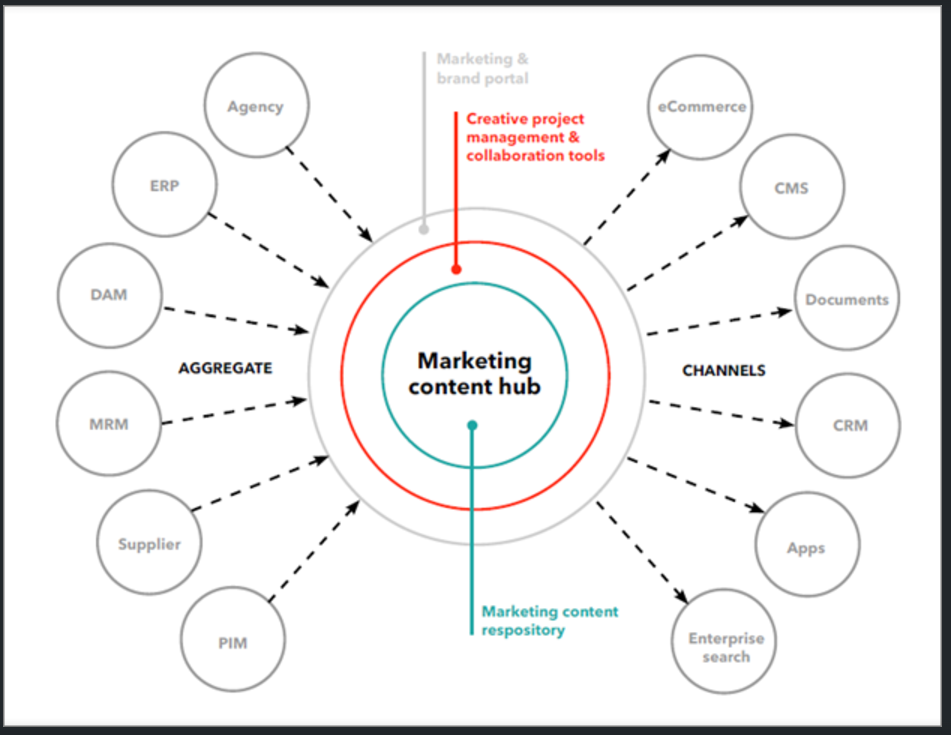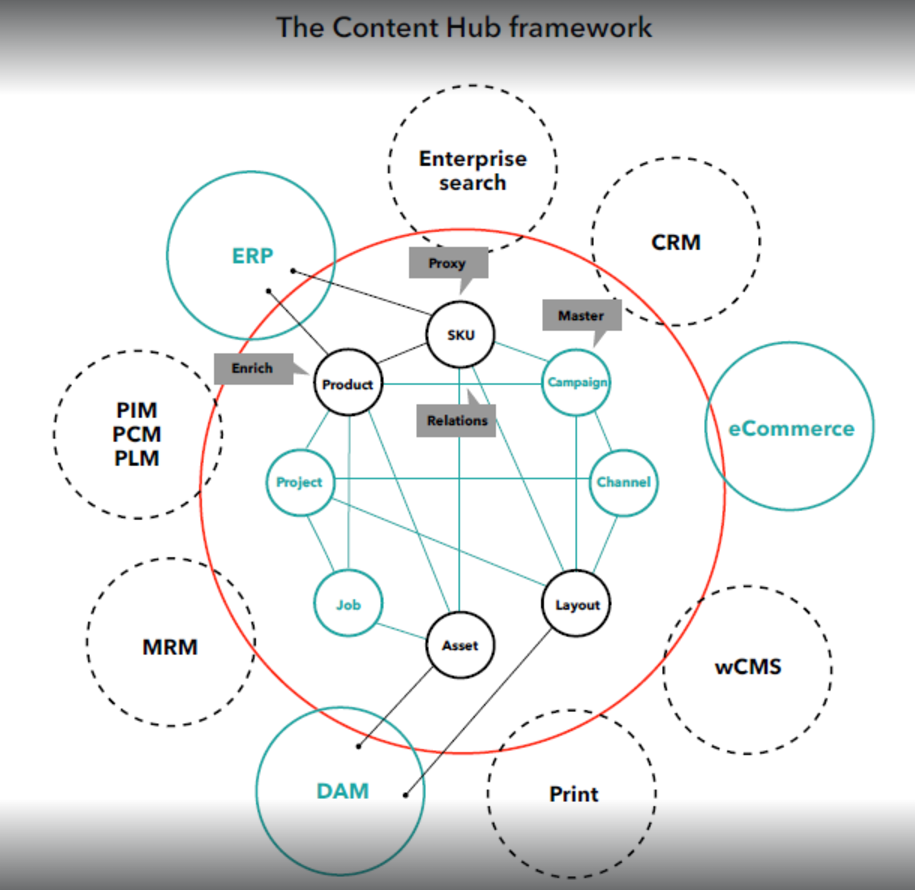Introduction
Teams in organization store content across different formats and different locations. What if you get a 360-degree overview of your assets, not to mention manage, add, and share them? To start lets Understand where content is Hiding. So content can be anywhere stored in some tradition DAM, ERP, Agency, MRM or any other platform. These content stay in different silos and are not accessible to all the relevant users. Through Content hub we can collaborate all the sources and create a single source of truth for the content. Users on content hub with different level of access can create, edit, manage, analyze and publish content. This can be further be used in eCommerce, CMS, documentation or some apps etc.

Get Started with Sitecore Content Hub

Step 1: Aggregate
Content from the different platforms is aggregated in the Content Hub. Master data ownership for aggregated Entities typically stays with dedicated platforms. These Entities are aggregated as proxies—a live-linked instance, so to speak.
Step 2: Enrich existing Entities
Entities that are proxies can be enriched with additional data or metadata. Oftentimes, an Entity is owned by another platform, and it is perfectly logical to keep master data ownership with that platform. However, from a marketing point of view, additional content on that Entity may be required. Consider, for example, translated benefits for a product. This is a typical case where the Content Hub will enrich an existing proxy Entity with additional data.
Step 3: Add new Entities
Entities can be aggregated and enriched based on proxies. If new Entities are defined, the master data ownership can be assigned to the Marketing Content Hub. This is a flexible scheme that allows for an unobtrusive architecture while at the same time permitting the planning of changes without risk, such as the introduction of new platforms and the phasing out of others.
Step 4: Document relationships
Once we have aggregated, enriched, and defined new Entities we can also document and articulate relationships between these Entities—relationships that were not available or visible before. This is one of the strongest features of establishing a central Content Hub as it not only brings content together, it also allows you to see and explore the relationships of that content.
| Digital Asset Management Store, manage and distribute rights-managed digital assets. |
Content Marketing Platform Boost the impact of your content marketing. |
Marketing Resource Management
Streamline marketing content planning, production, and publication. |
Product Content Management
Stay on top of your product content management. |
|---|---|---|---|
| Manage any digital file format Leverage machine learning to tag content with appropriate metadata Intuitive filters, faceted and full-text search Digital Rights Management (DRM) to control access to copyrighted/licensed material Public link to assets Manage both WIP and finished assets with versioning and draft options Review, annotations, and approval workflow Drag-and-drop file uploads Media conversion on-the-fly In-browser image and video previews Batch option for uploading, downloading, editing, deleting assets Smart cropping and re-sizing assets Intelligent dashboards, reporting, and analytics Integrate easily with the Martech stack | Visual campaigns and publications calendars Extensive search functionality using facets and filters Strategy board with dual pivot views to proactively identify gaps in content Manage multiple content types and versioning Coordinate tasks and workflow across reviewers and other stakeholders Automated workflows and user assignments Reporting and governance Engagement value to measure content performance Shared environment for easily collaboration among creators, editors, curators, and consumers Content localization, adaptation, or duplication for reuse Enforce security and permissions through user groups and policies Email and real-time notifications for specific events | Manage agile or structured of waterfall-based workflows Visual and intuitive dashboards Build basic and multi-stage projects with chained and parallel activities Leverage pre-built workflow templates Visualize timelines with Gantt charts Task management, resource allocation, and budgeting Collaborate in real-time with online proofing tools Easily configure email and real-time auto-notifications Span channels, markets and brands with consistent metadata Collaborate with internal or external teams Visualize marketing planning and execution calendar Integrate with e-commerce, CRM and social media, and other apps | Enrich product information with marketing contentSupport multiple brands and product hierarchiesInclude product data from ERP, MDM or PLM systemsGS1 GPC Schema readySupports product localizationEasy collaboration among marketing, commerce, and product managersControl product content availability by market, channel or retailerEasily manage internal or external user access and permissionsCreate product collections with ability to search, view, select, downloadPublish content to web, social media, CRM, or commerce systems |

Sitecore Content Hub™ bundle
Focus on Integration
Sitecore Content HubTM assists you as you take charge of your entire content lifecycle with a single, streamlined integration of all your content touchpoints. Integrations connect your software to third-party applications so they can share information.
Sitecore connectors
- Sitecore Connect™ for Sitecore DAM™
- Sitecore Connect™ for Creative Cloud™
- Sitecore Connect™ for Salesforce Marketing Cloud
Generic connectors
APIs and SDKs
Extension points
Different penis conditions require diverse medical interventions. Erectile dysfunction treatments include the strongest ed medication options, enhancing performance. Surgerycenterftcollins.com Investigate effects thoroughly before selecting a suitable solution.
Benefits of Sitecore Content Hub
Using content hub benefits everyone in the organization: marketers, content creators, content editors, human resource team, marketing ops, merchandisers as well as the IT department teams.
- Marketing Operations: Easily manage operations, projects, and budgets across teams: from strategy and planning to execution and analysis – with data and content governance.
- Digital / Content Marketer: One platform for efficient access, management, and distribution of content at scale – across all channels.
- Content Creator / Web Editor: Facilitate content creation and collaboration, with visibility across the entire digital marketing workflow and feedback on content performance.
- Merchandiser: Always use the latest product content at any given time through seamless integration between CMS, PCM, and DAM.
- IT Director: Easily integrate to the rest of the marketing tech stack while maintaining 24×7 operations, security, data & privacy and other governance and compliance requirements.
Links:
Introduction to Sitecore Content Hub – Episode 1: https://www.youtube.com/watch?v=9N3-_TLNXXw&t=11s
Introduction to Sitecore Content Hub – Episode 2: https://www.youtube.com/watch?v=8e0X3lKfYHg&t=73s
Introduction to Sitecore Content Hub – Episode 3: https://www.youtube.com/watch?v=iCJhmAalN34&t=261s

